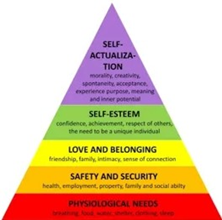Has the EV industry done enough to emotionally engage the consumer? Many traditional consumers, lovers of ICE vehicles, would say no. And so they remain with ICE vehicles. There isn’t a compelling enough reason to make the switch to electrification. For others, the financial and environmental benefits are enough compulsion.
Regardless of compulsions, the auto industry is one of the most emotionally invested consumer industries out there. And the EV sector is doing its part to continue to make it so.
Let’s use Maslow’s Hierarchy of Needs as a lens to support this assertion. Maslow argues that human needs can be encapsulated in his hierarchy. This tools is very useful in helping marketers determine (1) which needs to target and (2) which emotions to appeal to in targeting these needs. Here’s a quick refresher:
Maslow’s Hierarchy of Needs

What emotions do we feel?
- When our Physiology Needs are met, we feel relief and security.
- When our Safety Needs are met, we feel relief, security, comfort, and stability.
- When our need to belong is met, we feel love, connection, and camaraderie.
- When our need to feel esteem is met, we feel confidence, achievement, and uniqueness.
- When our Self Actualization is met, we feel inspired and deeply connected to our values.
More functional categories tend to play in the lower tier of Physiology and Safety. For example, most people don’t care what brand of paper towel they use as long as it picks up spills. As long as these products meet basic performance criteria, any brand will do and maybe even the lowest price point is preferred. While there are exceptions, these categories tend not to have the same level of emotional investment and consumer loyalty than those categories that position themselves higher up in the scale of emotional needs.
To that point, some categories speak to consumer needs of Belonging, Esteem and Self-Actualization. The teams we support help us feel connection and belonging to others. The clothes we wear and the cars we buy help us define our self-esteem. And the NGOs we support reinforce the values that make us who we are as self-actualized people. These categories and brands tend to drive higher emotional investment and stronger loyalty. Again, auto, by the stakes involved in the life of the consumer, is one of those categories.
So, the question isn’t really if the EV industry has been effective in emotionally appealing to our human needs, but really how effective it has been in doing so. And it HAS been very effective because many brands are well-entrenched for years. Traditional premium OEMs have borrowed from the quality, elitism and credibility of their longstanding history to promote their electrified line (e.g. BMW i5, Audi’s e-tron line). Despite recent problems in production and quality, Tesla’s brand is a rich emotional concoction of a
pioneer and proliferator of EVs and self-driving EVs, a technology visionary and through its mass availability, a beacon of trust for the EV-weary consumer. Even Rivian is focusing on the self-actualization and esteem that comes from being adventurers and lovers of nature.
Starting with Safety which is mostly a tablestake in auto (unless you’re Volvo that has differentiated itself around safety for decades). Safety concerns have permeated auto since its inception and the onset of EVs doesn’t make them immune to it. However, that these concerns exist is hardly a reason to say that the EV industry has not done its part to improve both the perception and reality of safety. For example, anecdotal concerns about fires from EV batteries during collisions. Liz Najman of Recurrent rightly describes, ICE vehicle fires can be frequent because of high flammability of gasoline. However, EV OEMs have automatic battery disconnects upon impact and also manual disconnects post-impact for first responders. Through the past 70 years, the industry has consistently worked to improve safety (e.g. seat belts, air bags, Lane Change Assist, Rear-Cross-Traffic alert, etc.). Battery disconnects is but one example of how the EV sector is doing its part too.
What about Belonging? With belonging, Maslow partially alludes to strength in numbers. Again, the industry has responded. Look no further than the EV clubs throughout the US led by the Electric Vehicle Association with 100 chapters and thousands of members. The EVA provides blogs, education and connection with local chapters to foster this sense of belonging. And even outside of the EVA, if you Google search for EV car clubs, you are likely to find one in your local region anywhere in the US. These clubs provide a critical function at this juncture of the EV industry in that they facilitate strength in numbers and are important to the proliferation of EV ownership, especially as the industry turns to target the masses.
Esteem is the fun one. This is how our vehicles appeal to our bravado, confidence and self-regard. And it’s not at all different from the feeling that ICE vehicles have provided to us since the Model T – after all, we all want cars to confer a status and an esteem to us that set us apart and make us feel alive. And how do EVs do that?
Let’s start with body design. EVs are things of beauty (for the most part). So much so, in fact, that one could argue that the proportion of stunning design with the EV introduction is greater than that of any new category in the history of the industry. It almost has to be because it’s a way to make EVs more appealing and less daunting.
Among others, the Pinninfarina Battista, the Rolls Royce Spectre and even the much more accessible (but game-changing), Kia EV9 and Mustang Mach E elicit that appeal in the same way that longstanding ICE vehicles have done. And this appeal will continue to grow with the burgeoning EV accessory industry, which incudes innovative products like Borla’s for the Mach E – a simulation of the sound experience for Mach E owners (via their Smartphone) – and will soon include other performance EVs.
Secondly, on esteem, let’s look at the interior design, and particularly the instrumentation and navigation panels. Here, EVs are setting a new standard for the entire industry. The spaceship-like interior of the Tesla Cybertruck (the same can be said of its exterior by the way), the cleanliness and efficiency of the Tesla Model 3/Y, and the cockpit-like view of the Rivian L1T are living examples of the versatile tech experience that EVs add to our daily drives. For those who derive esteem from being technology afficionados or from driving vehicles that feel futuristic and ahead of the curve, EVs meet the mark here too.
Finally, we reach the top of Maslow’s emotional needs and that is Self-Actualization. Far more than ICE vehicles ever have, EVs speak very deeply to the sense of morality, responsibility and inner purpose of Maslow’s Self-Actualization. When we drive our EVs, somewhere in our subconscious, we feel a sense of moral contribution to our community via cleaner air and a more environmentally secure future for our children. Maybe we even feel patriotism via a reduced reliance on fossil fuels and the national security concerns this reliance can carry. There is deep purpose underlying these values and it is this purpose that is among the foundations on which the EV industry was created and has grown.
Yes, the EV industry is not without issue to consumers. As the industry more fully exhausts our Innovators and Early Adopter consumers, penetrating the Early Majority is highlighting many of these. Range anxiety creates safety concerns of being stranded. We hesitate to let go of the esteem of the classic look of our ICE vehicles and even the virility of the noise that they make (though products like Borla’s above will change that perception too). And we are turned off by the financial and even moral superiority Innovators and Early Adopters directly or indirectly communicate in EV ownership. There is a way to go in overcoming these perceptions and allowing the Early Majority to feel emotionally connected to EVs. However, the industry deserves credit for being well on its way.


